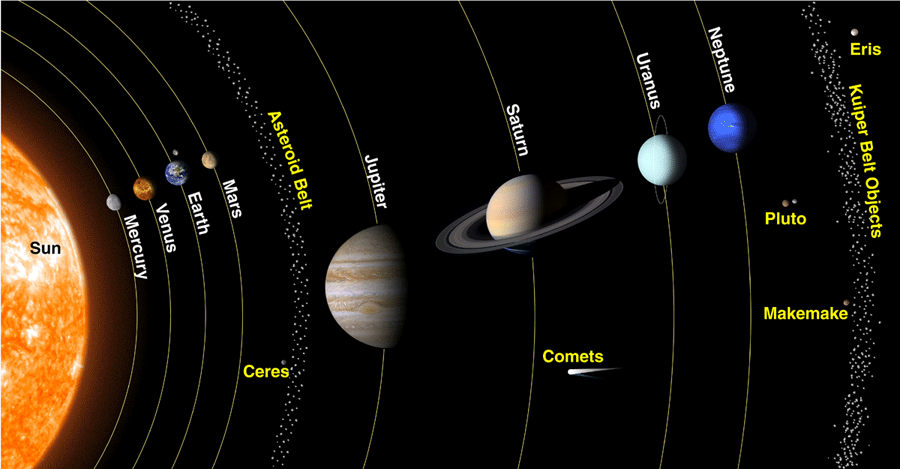Some of the major objects within 100 AU of the Sun are omitted from the above – four major moons of Jupiter, one of Saturn and one of Neptune – all of which are much larger than the “dwarf planets” highlighted above. Several major asteroid populations are subsumed into “the Asteroid Belt” and the “Kuiper Belt Objects”. Jupiter and Neptune have large populations of asteroids sharing their orbits in the leading and trailing Lagrange points, the so-called Trojans. Also the Centaurs range between Jupiter and the Kuiper Belt, grading into the so-called “Jupiter Family Comets”, some of which are sourced from the Kuiper Belt, Neptune Trojans & Centaurs, while the rest are from the Oort Cloud.
The Trans-Neptunian region, beyond the Kuiper Belt, is little known. Several largish objects are known in that region, like Sedna, and their dynamics suggests the existence of one or two Mars to Super-Earth sized planets just beyond them, at perhaps 200 to 250 AU. We’ve discussed such objects here before, so let’s move a bit further out, into the Inner and Outer Oort Cloud. We see comets come falling towards the Sun from somewhere this side of ~22,000 AU. Based on the best orbital data, the quasi-spherical Oort Cloud that the comets must fall from extends out to about ~2/3 of a light-year. Doesn’t sound like much when said like that, but that translates into 44,000 AU – forty-four thousand times the distance between the Earth and the Sun. Our “Inner System” – the spherical volume ringed by the Classical Kuiper Belt at ~44 AU radius – occupies just 1 billionth of the volume. How many comets might it have? How could we even know?
Actually we do have a pretty good idea. Firstly, the Oort Cloud comets give us some statistical meat to chew on, producing estimates between 100 billion and 10 trillion comets. An average comet is somewhere between 1-10 km across and at ~1,000 kg/m3 density, that’s a mass between several times the mass of Earth to several Jupiters. How did it get there? Currently the comets are believed to have been ejected mostly by Jupiter and Saturn as they changed orbits during the early days of the Solar System via interacting gravitationally with billions of “planetesimals”, the leftovers of planet formation which became the comets.
While a trillion comets seems an immense resource, they’re spread very thinly – that 44,000 AU radius volume means each comet has, on average, about ~400 cubic AU to itself. Even more widely spread will be the estimated ~1,000 or so Pluto-to-Earth-Moon-sized “planetary embryos” that different planet formation theorists have postulated. These too would’ve been flung from the Inner System by the migrating Gas Giants. At the upper end of the mass scale there might be Mars-to-Earth sized objects. If such objects have significant geophysical heat sources and captured a H2/He envelope from the proto-Sun’s Nebula, then they might retain sufficient heat to have liquid water oceans. Alternatively they might have water-ice crusts and buried oceans, if stripped of their proto-atmospheres.
Could a planet-sized world be cold enough for more exotic oceans, like hydrogen? I have discussed the possibility before, but hadn’t closely examined the requirements of such a state of affairs. Large masses of rock are “warm” compared to cold stuff like liquid hydrogen (~20.3 K), let alone frozen hydrogen (13.8 K) or even liquid helium (~5 K under pressure.) If we assume the usual heat-source suspects, the radioactive decay of Uranium, Thorium and Potassium-40, then planets with significant fractions of rock (which contains U, Th & K naturally) are unlikely to ever get cold enough. Earth, which is 2/3 rock, has an equilibrium temperature of 34.4 K – and no amount of pressure can keep hydrogen liquid at that temperature, as its critical point is 33 K at 13 bar. Outcroppings of colder rock might allow pools of the stuff, but never oceans. Even if Earth’s geothermal output came from just radioactive decay (rather than ~50%) and the heat of formation had dissipated, the equilibrium temperature is still 28.8 K.
If we reduce the rock fraction, then we might be able to get closer to liquid hydrogen conditions. Using the mass-radius relations for different materials, derived by Sara Seager and her team, I’ve computed the equilibrium temperature for different planets. Of course we might posit planets with NO silicates, but no such planet (dwarf or otherwise) is observed in our solar system, and even comets have some fraction of “grit”.
Here’s a summary table for different compositions – a “Mercury-like” planet that’s just 32.5% silicate (i.e. half Earth’s); a pure Silicate planet, and an icy planet that is only 22% silicate. Mass and Radius are in “Earths”, while ‘T(eq)’, is the Equilibrium Temperature in K.
A very Icy planet, as you can see, could easily support liquid hydrogen on the surface, as could the smaller Mercury and Silicate planets. Even an Earth composition would come close. But there’s a complication. Hydrogen is a greenhouse gas and significant amounts of it as gas will quickly raise the surface temperature, holding in the heat from the rocks. Depending on how much you have, it might be warm enough for nitrogen oceans (~63 K) or ammonia (196 K) or even liquid water (~273 K).


